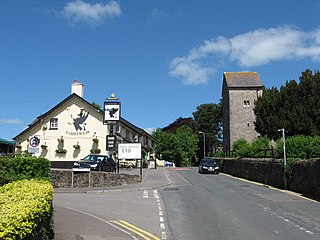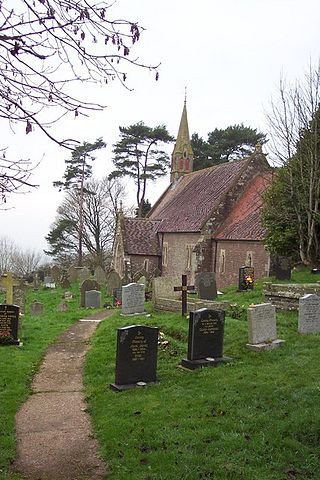
Thornhill is a community in the north of the city of Cardiff, Wales. It lies south of Caerphilly.

Rhiwbina is a suburb and community in the north of Cardiff, the capital of Wales. Formerly a small hamlet within the parish of Whitchurch, Rhiwbina was developed throughout the twentieth century, and is now a separate ward. It retains aspects of its former character, however, and is given a Welsh village appearance by Beulah United Reformed Church at the village crossroads.

Llanishen is a district and community in the north of Cardiff, Wales. Its population as of the 2011 census was 17,417.

Lisvane is a community in the north of Cardiff, the capital of Wales, located 5 miles (8 km) north of the city centre. Lisvane is generally considered to be one of the wealthiest residential areas of Wales, with many properties worth in excess of £1 million. Lisvane had 3,319 residents in 2001 and comprises approximately 1,700 dwellings, a local village shop, primary school, community cabin library, park, nursery, parish church, public house, war memorial, Scout hall and community or village hall.

Cyncoed ; is a community in the northeast of Cardiff, the capital of Wales. With many properties in the area fetching over £1 million, Cyncoed is considered to have some of the highest property prices in the country. Cyncoed overlooks the city centre of Cardiff, near Roath Park, with views of the surrounding mountains.

Llanedeyrn is a former village, now a district and community, in the east of the city of Cardiff, Wales, located around 3.5 miles from the city centre. The parish of Llanedeyrn rests on the banks of the river Rhymney and is visible nesting on a hill side above the A48(M), westbound on the approach into Cardiff.

Cardiff North is a constituency represented in the House of Commons of the UK Parliament since 2017 by Anna McMorrin of the Labour Party.

The Diocese of Llandaff is an Anglican diocese that traces its roots to pre-Reformation times as heir of a Catholic bishopric. It is headed by the Bishop of Llandaff, whose seat is located at the Cathedral Church of Saint Peter and Saint Paul in Llandaff, a suburb of Cardiff. It currently covers most of the former Welsh county of Glamorgan, but once stretched from the River Towy to the middle of the Wye Valley.
York had around 45 parish churches in 1300. Twenty survive, in whole or in part, a number surpassed in England only by Norwich, and 12 are used for worship. This article consists of a list of medieval churches which still exist in whole or in part, and a list of medieval churches which are known to have existed in the past but have been completely demolished.

Llanishen is a village in Monmouthshire, southeast Wales, United Kingdom. It is located 7 miles (11 km) southwest of Monmouth and 3 miles (4.8 km) south of Trellech on the B4293 road, although the main part of the village is set immediately to the west of the road, overlooking the Vale of Usk.

Edwin Seward (1853–1924) was an architect based in Cardiff, Wales.

Llanishen Reservoir is a Victorian reservoir in north Cardiff, Wales. The reservoir is one of the reservoirs constructed as part of the Taff Fawr scheme for supplying water to Cardiff and was completed in 1886. It forms part of the Nant Fawr Corridor from the top of Roath Park to the countryside beyond Cyncoed.

Saint Isan was a 6th-century saint of South Wales and Patron Saint of Llanishen in Cardiff, Wales.

Llanishen Methodist Church, also known as Century Chapel, is a listed place of worship in Llanishen, a suburb of Cardiff in Wales.

St Isan's Church is a listed Anglican church in the suburb of Llanishen, Cardiff. The church's origins are medieval, though the present building was extensively remodeled during the Victorian and Edwardian years.

St Edeyrn's Church is a listed Anglican church within the boundary of Old St Mellon's, Cardiff, though giving its name to the nearby area of Llanedeyrn.

St Dochdwy's Church is a historic listed church in the village of Llandough, near Penarth in the Vale of Glamorgan, Wales.

Ty Gwyn is a large detached house in the Cardiff suburb of Lisvane. It is set in 5 acres of grounds and is 10,000sq ft in size.
















